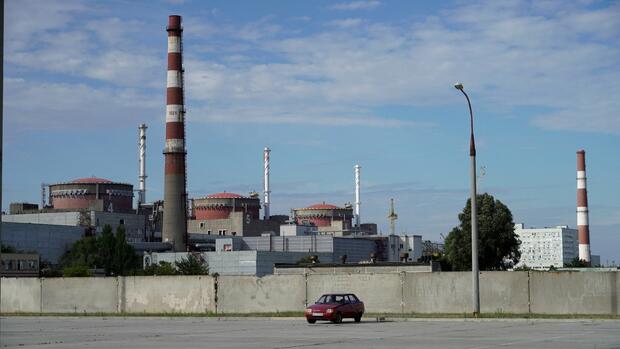Europe’s largest nuclear power plant, which has been controlled by Russia since the beginning of the war, is around 150 kilometers northeast of the damaged dam on the south bank of the reservoir.
(Photo: AFP/Getty Images)
Berlin The destruction of the Kakhovka dam in southern Ukraine exacerbates the non-precarious location of the nearby Zaporizhia nuclear power plant. The International Atomic Energy Agency (IAEA) warned of this. Even before the dam broke, the situation was “extremely fragile and dangerous,” as the organization explained at the end of May.
IAEA Director General Rafael Grossi announced that the dam burst itself “currently does not present any immediate danger to the safety” of the power plant. There is no risk of flooding, as the power plant is located on the river course above the dam and the water flows southwest across the Dnipro River into the Black Sea. However, the supply of cooling water must be permanently secured. So far, this has come from the reservoir, the water level of which is now falling inexorably.
According to the IAEA, the level was still 16.40 meters on Tuesday morning at 8 a.m., but is falling by around five centimeters every hour – that is 1.20 meters per day. As soon as the level falls below 12.70 meters, water can no longer be pumped towards the nuclear power plant.
However, the water tank located directly at the power plant, which is fed from the reservoir, is very large and should, in case of doubt, ensure cooling for several months, said Grossi. But it is essential that this tank remains intact in any case. “Nothing must happen that could potentially endanger his integrity,” he appealed to Kiev and Moscow.
The nuclear power plant had to be operated with diesel generators seven times
Europe’s largest nuclear power plant, which has been controlled by Russia since the beginning of the war, is around 150 kilometers northeast of the damaged dam on the south bank of the reservoir. The IAEA, like the western community of states, has repeatedly pushed for an end to the hostilities around the nuclear power plant in order to avoid risking damage and radioactive fallout.
Last September, the last of the plant’s six reactors was shut down. However, that doesn’t mean they’re no longer a threat. After all, reactors that have been shut down also have to be cooled for several years in “post-operation”. This is the only way to prevent a core meltdown and the release of radioactivity, which led to the catastrophe in the Japanese nuclear power plant in Fukushima.
The Ukrainian nuclear company Enerhoatom also saw no acute danger to the operation of the nuclear power plant as a result of the destruction of the dam. “We do not consider the situation to be critical, since the Zaporizhia NPP has its own cooling basin, which is not connected to the Kakhovka reservoir,” Enerhoatom director Petro Kotin said in a television interview.
The cooling water is not only needed for the reactor itself, but also to cool the diesel generators in emergencies. It is currently unclear whether the power supply to the nuclear power plant is still intact or has been interrupted due to the damage to the reservoir hydroelectric power plant. Neither the IAEA nor the German authorities provide any information on this.
Because the external power supply had repeatedly failed before, the power plant and its cooling system had to be operated with emergency diesel generators seven times, according to the IAEA. These then regularly represent “the last line of defense against a nuclear accident,” said Grossi – for the last time in the second half of May.
Dam rupture: Scholz speaks of a “new dimension” in the war
“We’re lucky that there hasn’t been a nuclear accident so far,” Grossi said a week ago – not knowing how much the situation would now deteriorate. “This is a dice game, and if it continues like this, one day our luck will run out.”
Grossi now really wants to start his inspection trip to the nuclear power plant, which is planned for the coming week, he announced. A handful of its experts have been permanently stationed in Zaporizhia as neutral technical observers since September.
More: Since the outbreak of war there has been fear of a nuclear catastrophe in Zaporizhia
